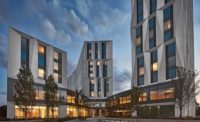Chicago’s financial and construction markets were devastated in the Great Recession, so the completion of work on one of its prominent victims is reason enough to celebrate. The luxury apartment building now standing in Chicago’s downtown Loop at 111 W. Wacker Dr., dubbed OneEleven by its developer, can claim even greater distinction: OneEleven has now earned ENR Midwest’s award for the region’s Best Project of the Year.
Originally designed as a 90-story hotel and condominium tower, the property was abandoned mid-construction in 2007, leaving only the 28-story concrete structure and miscellaneous MEP elements in the building. The abandoned structure stood as an unwelcome reminder of the condition of the local economy and symbolized, for many, the slowdown in construction that resulted from the financial market collapse in 2007. Now, the completed OneEleven symbolizes the re-emergence of Chicago’s financial and construction markets.
Chicago-based developer Related Midwest in 2011 re-envisioned the building in a collaboration with Lend Lease (US) Construction Inc. and designers. The process transformed OneEleven from a planned Shangri-La Hotel in the podium structure topped by a 60-story tower with 1,800-sq-ft condominiums into a 60-story apartment building with units about half the size originally planned.
For OneEleven, Handel Architects and Epstein designed a 945,000-sq-ft concrete structure with curtain-wall exterior. The building includes 504 luxury apartments—studios, convertibles and one-, two- and three-bedroom units—with high-end appointments, a 30,000-sq-ft amenity area including pool and fitness spaces and 32,000 sq ft of retail and restaurant space at the ground level. The building also features four below-grade and 11 above-grade levels of parking.
“Opportunities made this job successful,” says Ross Weyman, Lend Lease vice president and project executive. Reuse of the existing 28-story concrete structure created opportunities for structural design innovations. To accommodate offsets between tower and podium grids, crews placed a 60-in.-thick, two-way, post-tensioned transfer slab on the structure’s 30th floor, an undertaking involving 2,253 cu yd of 6,000-psi concrete and two continuous pours.
“You expect to see a mat of that magnitude being poured in the ground, not in midair,” says Bert Brandt, Lend Lease senior vice president and project executive. “It’s not something any of us who worked on it expect to see again in our lifetime.”
The overall construction scope included the demolition of select areas of the existing structure and existing MEP systems, new concrete structural components from level 29 through 60, complete interior construction for all levels and site improvements. “A big challenge was the MEP,” says Weyman. A portion of the hotel’s MEP had been installed, but the entire tower was now to become condominiums. The installations were demolished and more than 6,500 new MEP penetrations were cut.
With 28 floors of existing structure in place and residential build-out floors spanning levels 15 to 58, the project team saw a key opportunity that saved months on the project schedule. Through an innovative stack joint design and careful planning, the project was able to install the exterior curtain-wall system in multiple locations at the same time. The team started the glass installation on level 14 and level 30 simultaneously, as these levels corresponded with the lowest residential floor in both the lower half and upper half of the building. The ultimate result was two interior build-out flows in the building. “We built two jobs at the same time and completed them twice as fast,” says Weyman.
The building’s site is tightly bound by Wacker Drive and Clark Street, across from the Chicago River and in the middle of the North Loop Chicago River skyline. The traffic on Lower Wacker and the Upper Wacker bridge structure bordering the site to the north added to the site’s logistical challenges. The most efficient tower crane placement was the north side of the site, along Wacker Drive.
Placement of the tower crane inside the structure was neither cost-effective nor conducive to the aggressive unit turnover schedule, so the tower crane foundation was designed to cantilever from the existing structure’s oversized column at level 3. This allowed the team to avoid disturbing the Upper Wacker roadway and maintained ground floor access for deliveries to the project site.
One-Eleven
Chicago
Key Players
Owner Related Midwest
Lead Design Firm Handel Architects LLP
Architect of Record Epstein
Contractor Lend Lease (US) Construction Inc.
Structural Engineer Halvorson & Partners
Civil Engineer Spaceco Inc.
MEP Engineer Cosentini Associates Inc.






